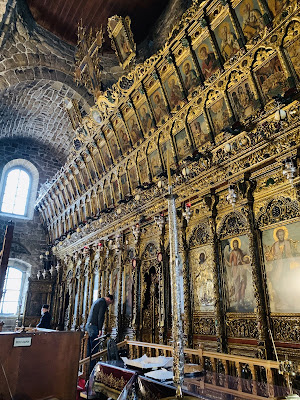This is a huge church we passed on the highway
A small little church on the rocks of Cape Greco.

Cape Greco
A birdge made our of the rock.
Our next stop was Agia Napa Monestary. It was built around 1500 AD.
Being silly
This is the Hala Sultan Tekke Mosque. It is near Lanarca. It is apparently built on the burial site of Umm Haram who was the aunt of the prophet Mohammed. She was buried here in 649 A.D. A shrine was originally built here, and then the mosque. This mosque is no longer used on a daily basis - only twice a year when pilmgrims come for high holidays. Umm Haram is still buried here.
The original shrine
On the drive to the airport we saw a huge group of flamingos in the water. It is hard to tell from the pictures. There were hundreds of them.
The mosque
Lazarus Church. So St Lazarus lived out his final days after his resurrection in Cyprus. His tomb was discovered here (and it is still here). His bones were removed centuries ago and taken to Constantinople. But now they don’t know where they are. HOWEVER - the church does have some bones on display that they say they kept before St. Lazarus was removed.
St. Lazarus was known as the Friend of Christ.who after being dead 4 days was raised by Jesus.
Later, Lazarus was forced to seek refuse in Cyrpus because there was a plot of cheif priests to kill him. He was raised from the dead in 33 A.D. and then lived another 30 years in Cyprus and died around 63 A.D. After he died, he was buried where this church stands today. This is his tomb and on it inscribed "The 4 day dead and Friend of Christ"
Lazarus' time as a bishop in Cyprus is unknown because either records were not kept or they were destroyed.
These are supposedly St. Lazarus' relics. They were originally discovered in 890 A.D. in his tomb in a small church that existed at that time. The then emperor carried them to Constantinople and in exchange sent money to build the church that stands today. It is said that these relics that sit in the St. Lazarus church are what the Cypriots kepts (unknown to the emperor) when the bones were moved.
After the capture of Constantinople by the Franks in 1204, the Crusaders, besides the other treasures they carried to the West, they also carried the Saint’s relics to Marseilles, from where, later, they disappeared and up to the present day they have not been traced.
It is know that since the occupation of Cyprus by the Turks in 1571 until the middle of the 19th century, all beifrys were banned by the conquerors as well as the use of bells in christian churches. The ban was lifted in 1856 after a demand lodged by Christian Orthodox Russia, but even then, the use of bells was allowed only after obtaining a permit from the Vizier

























































No comments:
Post a Comment